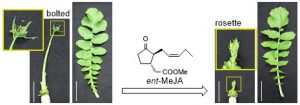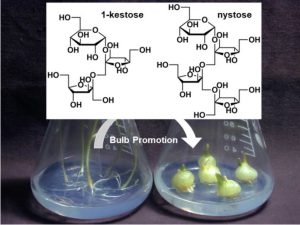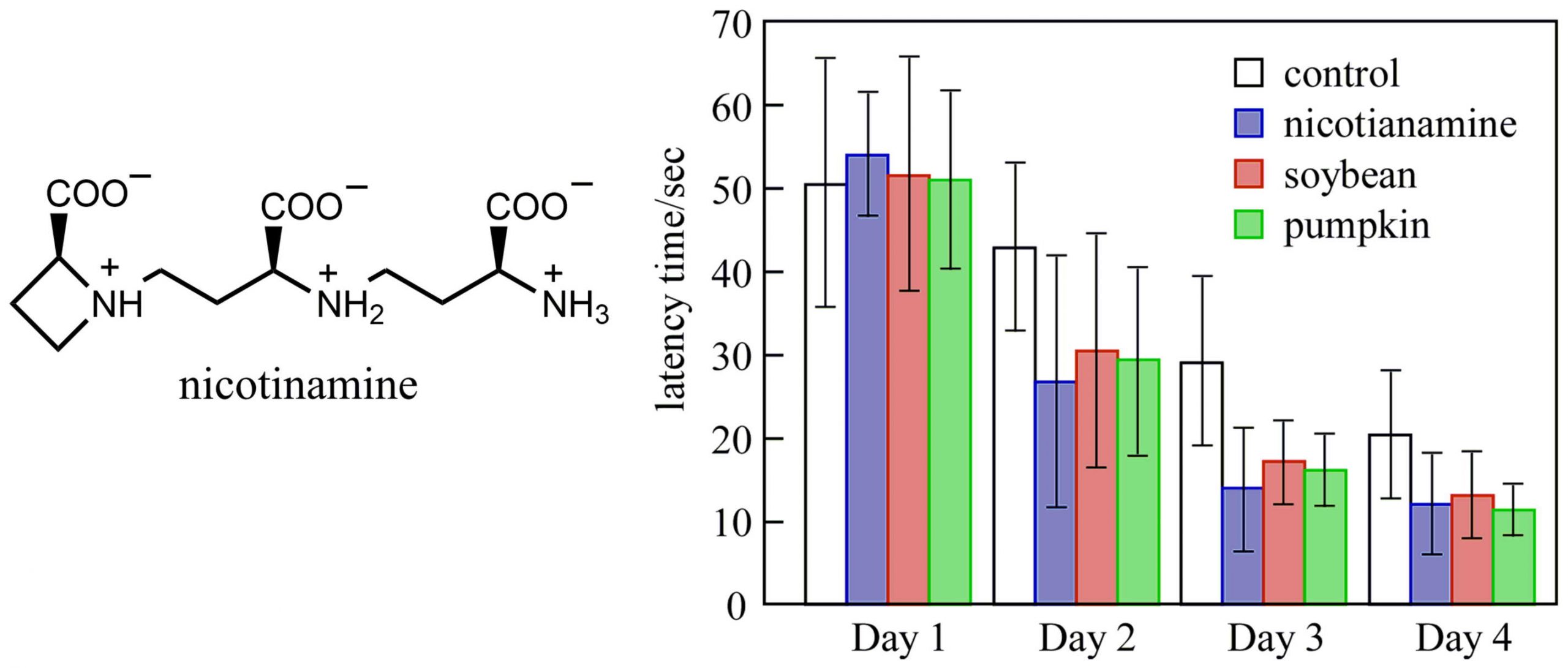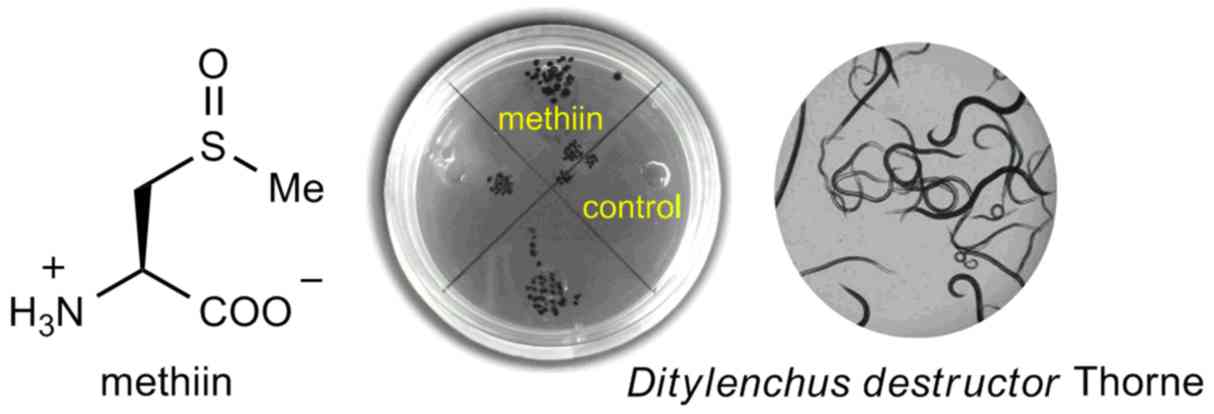Plants have numerous phytochemicals rich in diversity, some of which regulate plant growth. We investigate on identifications and functions of the plant growth regulators, especially concerning crop productions. In particular, we focus on when, where, and how the phytochemicals work in the plant body. We are also interested in developments of ecofriendly-agrochemicals by structure-modifications using organic synthetic techniques.
On the other hand, some phytochemicals, such as alkaloids, contribute to our health as drugs. We are also interested in developments of novel medicines by thorough biological activity evaluations and structural modifications of phytochemicals.
KEYWORDS: Natural Products Chemistry, Phytochemistry, Plant Physiology, Medicinal Chemistry, Isolation and Spectral Analyses (NMR, IR, MS, and so on) of Phytochemicals, Organic Syntheses, in vitro and in vivo Bioassay.
1) Plant Growth Regulators Project
Radish sown in summer has a short stem (rosette) as a result of inhibition of internode elongation. After winter (vernalization), exclusive stem elongation (bolting) and flowering are induced by endogenous hormonal factors. In cold areas such as Hokkaido, early-spring sowing induces unexpected bolting because of chilliness. Bolted radish contains large amount of inedible fiber, and the amount of sugar in the root decreases. Thus, unexpected bolting causes great damage to the production.
We recently identified the antiboting compound in radish leaves and demonstrated that one of the metabolites (methyl jasmonate) inhibits the bolting of radish. However, methyl jasmonate could not become an adequate bolting inhibitor due to its undesirable effects, such as senescence inducing activity. Thus, we investigated the structure-activity relationship (SAR) study of methyl jasmonate, leading to development of new bolting inhibitor (methyl ent-jasmonate) without undesirable effects.

Under long days, onions form spherical bulbs and accumulate nutrients such as fructose-based oligosaccharides (FOS) in their bulbs. 1-Kestose and nystose, inulin-type FOS, have been identified as endogenous stimulants of bulb formation. According to the structure-activity-relationship study, the inulobiose moiety in 1-kestose is required for the bulb formation. Inulin-type FOS is well known as a prebiotic, which is beneficial to people’s health, and does not show toxicity. FOS has not been linked to any negative crop growth effects. Thus, it could be a potential eco-friendly growth promoter.

The leaves of soybeans (Glycine max L.) suddenly begin to senesce simultaneously during seeds development, a phenomenon known as monocarpic senescence. The removal of pods delays senescence, suggesting that pod production plays a key role in triggering its onset. In this study, the authors aimed to identify senescence inducing compounds in soybean pods, ultimately identifying abscisic acid (ABA) as a senescence inducing compound and both jasmonic acid (JA) and 12-hydroxyjasmonic acid (12-OH-JA) as synergistic compounds that enhance the effect of ABA. The quantitative results aligned with the assay findings, confirming that the senescence inducing activity of pod extracts can be attributed to the combined presence of three compounds. Especially, fluctuations in 12-OH-JA levels in pod extracts closely correlated with variations in the senescence inducing activity, suggesting that 12-OH-JA acts as a synergist in monocarpic senescence in soybean plants, alongside ABA as the primary senescence inducing compound.

2) Antihypertension and/or Antidementia Drugs Project
Hypertension is currently considered as one of the most serious long-term medical conditions worldwide. Angiotensin I-converting enzyme (ACE), as one of the key-targeting component for hypertension drugs, converts angiotensin I to vasopressor angiotensin II through a catalytic hydrolysis process. Recently ACE has been proven to exist in higher levels in the brain cells of Alzheimer disease patients. Brain-penetrating ACE inhibitors (ACEIs) decreased the impact of Alzheimer disease in elderly hypertensive patients.
It is expected that the inclusion of ACEI-rich foods in meal plans has a potential for the elimination of these health issues. Therefore, we explored the occurrence of ACEIs in food extracts combining ACE inhibition assay with LC/ESIMS quantification analysis, revealing that naturally occurring nicotianamine (NA), ubiquitously present in higher plants, is an important constituent in ACEI active foods. Furthermore, oral administration of NA and NA-rich food extracts improved spatial learning and memory functions in rats, in addition to hypertensive relief in rats. Thus, NA is suggested to be a brain-penetrating ACEI, while the inclusion of NA-rich foods in meal plans will contribute to improve the “quality of life” of patients by relieving hypertension and dementia, such as Alzheimer disease.

The mode of action of NA remains unclear, due to lack of crystallographic data. Then, we performed SAR study to discover that a phenylalanine analog displayed the most potent ACEI activity, corresponding to that of captopril. Additionally, molecular docking studies with Gold program were performed to predict the binding poses of NA and its analog, suggesting that NA and its analogs combine a plausible allosteric site in an area away from the catalytic site in ACE. These results proved a possibility of structural modification of NA to develop antihypertensive drugs.

3) Nematode Attractant Project
Damage to garlic (Allium sativum) caused by a nematode Ditylenchus destructor are becoming a serious agricultural hazard, leading to a great loss in garlic production. Once the garlic bulbs are invaded, the pathogenic nematode drastically increases the population along with the rotting of bulbs. It was therefore conceived that nematode attractants are present in the bulbs. Based on this hypothesis, chemical investigations were performed to explore a nematode attractant in A. sativum bulbs, which resulted in the identification of methiin (S-methyl-L-cysteine S-oxide) as an attractant. Bioassay and quantification experiments of methiin in A. sativum bulb extracts led to a conclusion that methiin possesses sufficient potential to attract D. destructor into A. sativum bulbs.

